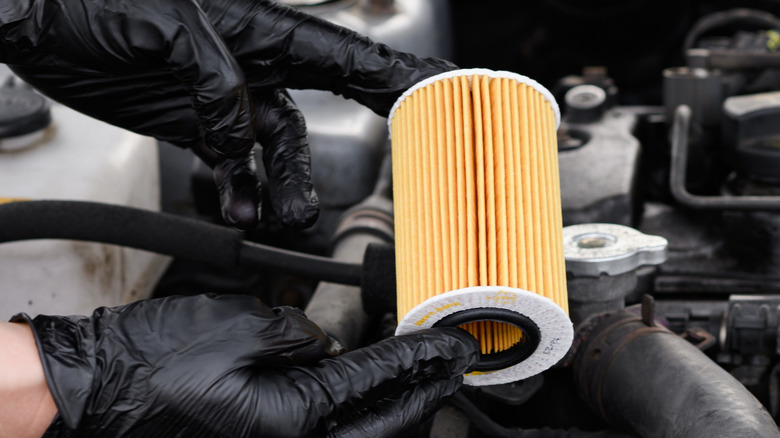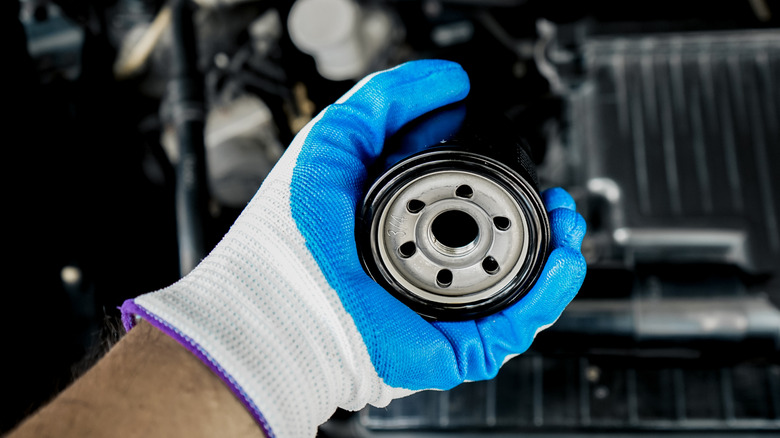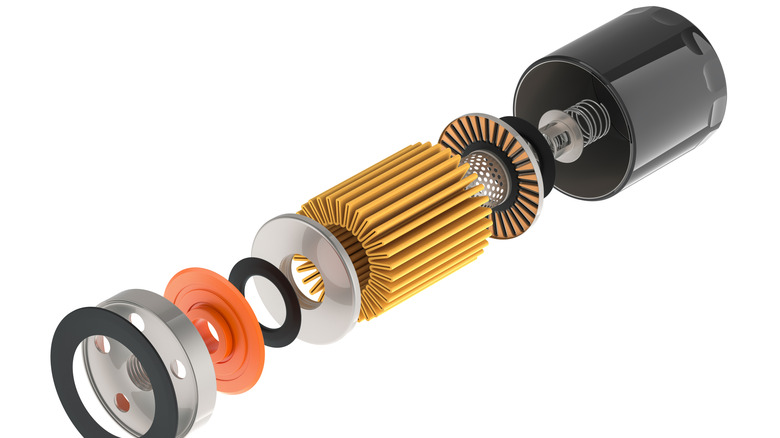Why (And When) Did Cartridge Oil Filters Replace Spin-Ons?
While we normally think of engine oil as a closed-loop system, the reality is that oil picks up particles and contaminants all the time. There's a reason why engine oil turns black over time, after all, and it's not because it's in a bad mood. The oil turns black when it's been saturated with carbon deposits, soot, or just plain heat decay. Enter the oil filter: a device designed to segregate these particles from the oil and allow it to run as pure as possible.
If you've changed your own oil on a car that's older than about ten years, it's likely that you spun off a big metal can on the side of your engine block and put a new one on as part of the oil change procedure — that's the oil filter. More specifically, that's a spin-on oil filter, a type that was introduced back in 1954 by Wix Filters, which involves changing the complete filter and housing as a single unit. Before that, however, we had something else: cartridge oil filters, which operate more or less like air filters on modern cars.
For those who don't know, a cartridge oil filter functions like a spin-on filter, except in reverse; instead of the oil being pumped inside the filter, a cartridge filter takes the oil from the outside and sucks it in. Plus, unlike spin-ons, cartridge filters only involve replacing the paper element and inner structure, as opposed to the entire housing. Undoubtedly, this saves a tremendous amount of material and manufacturing time, but are there any other benefits to your engine? Let's dive in and discuss.
The pros and cons of cartridges and spin-ons
Ultimately, at least from your car's standpoint, there's little difference between a cartridge and a spin-on oil filter. It's less about the way the filter is fitted and more about the filter's properties and how it works, such as its size and what materials it uses. Regardless of whether it's a cartridge or spin-on, going from a paper element to a fully synthetic element with a thinner mesh will filter better.
From an end-user's perspective, however, there are a couple of advantages and disadvantages to each. For a cartridge oil filter, its main advantage rests in being able to observe the thing for wear and damage. Unless a spin-on oil filter has visible damage like a dent, you likely can't tell if something on the inside is defective or malfunctioning. That's not the case with cartridge filters; just open the top cover and inspect the filter to confirm if everything's okay. Again, much like an air filter. Conversely, spin-on filters are typically more straightforward to install: unscrew the old one, lubricate the new gasket, and screw the new one into place.
There are some downsides to both as well, of course. With cartridge oil filters, you often need special tools like a specific wrench to access the housing, and it's sometimes easy to overtorque the cap or seat the filter improperly if you're not used to it. Moreover, spin-on oil filters tend to be cheaper than the equivalent cartridge oil filters.
Why more manufacturers are switching
The main problem to overcome is making enough filters in enough volume to make sense to both suppliers and the customer. Unlike spin-on oil filters, cartridge-based filters tend to be engine-specific, meaning the filter fits only a few models of car, versus spin-on filters, which tend to be more universal. This means it's less practical for suppliers to order cartridge filters in bulk, and thus, the prices are higher for these versus spin-ons. However, cartridge filters are experiencing a resurgence, both in European cars and diesels, the latter of which enjoy the additional surface area cartridge filters afford when compared to spin-on filters. Newer-model USDM and Japanese import cars also have cartridge filters, though it's less prevalent the further back you go.
Go back far enough, however, and you'll loop back around to cartridges; for example, the small-block Chevy used cartridge-based filters up to 1967, hence why sites still carry those early cartridges and conversion kits. Ultimately, they were ditched as a matter of convenience, since older screen-based filters were a pain to change, something you'll learn if you choose to daily certain classic cars daily. These days, with advancements in technology and environmentalism of higher importance, it's cartridge filters again to the rescue — another nice boon is, of course, no metal involved in cartridge filters' construction. And as more and more vehicles adopt cartridge-based filters and the market becomes more standardized, theoretically, the prices may begin to even out as well.


